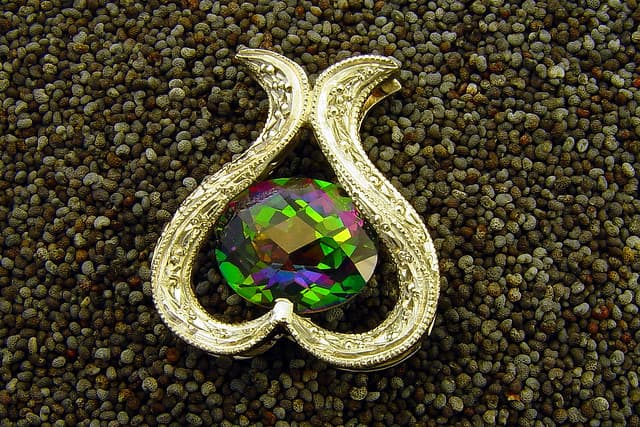How Does Vapor Deposition Create Mystic Topaz and Aqua Aura Quartz?
Vapor deposition can be used to enhance gemstones like topaz and quartz with a metal coating or sheen. Learn how the process works here.
2 Minute Read
How Vapor Deposition Creates A Metal Coating
I once built and operated a machine for vapor deposition. Imagine a glass bell jar connected to very powerful vacuum pumps. I had a good mechanical pump that created a vacuum of less than one millimeter of mercury pressure. But that's only useful for sputtering. Evaporation requires a fairly high-voltage arc and electrodes composed of the metal that you want to deposit on a gemstone or other surface. Sputtering doesn't give quite as good a result as evaporation.
At that pressure, I activated a pair of large rings at a voltage of 10,000v AC. This bombarded the job (in my case, 3-inch concave glass lenses) with atoms of very active oxygen, which cleaned up any microscopic traces of organic material remaining after a very thorough initial cleaning.
During this bombardment process, the entire bell jar glowed with a pale violet-pink light. After a few seconds, I switched this off, and the oil diffusion pump started up. This pump had no moving parts but could pull a vacuum of 0.00001 mm of mercury pressure, but only if the mechanical "backing pump" had removed the majority of the air first.
Next, I applied a low-voltage, high-amperage current (about 50 amps at 3 volts) to a heavy tungsten coil. The coil became white hot. Bits of gold, copper, and aluminum (or other metals which had been clipped on to it) began to boil and evaporated. Since there was very little atmosphere in the jar at this stage, the metal atoms got sufficient energy to travel in straight lines without colliding with air molecules anywhere in the jar. These metal atoms then coated the jar and anything inside it.
Sometimes, instead of using a tungsten coil, a little boat-shaped dish is used to contain the metal to be evaporated. Pure silica is often used, too. The vapor deposition process is completely controllable. You can create a coat of any thickness up to a micron or two. You can create an iridescent effect over rocks, glass, cabochons, or other cut gemstones.
John Burgess
More Applications of Vapor Deposition
Vapor deposition, also called vacuum deposition, is a widely used process. In electron microscopy, viewing samples receive gold coatings this way, since the electron microscope can only accurately image a conductive surface. Plastics can also be "metalized." Some plastic toy models have chromed parts made in this manner.
It's possible to hook up multiple electrodes or coils simultaneously in the vapor deposition process. Since they don't have to be the same materials, you can deposit layers of a metal mixture that might be quite hard to produce by other means.
Peter Rowe
International Gem Society
Related Articles
Topaz Value, Price, and Jewelry Information
Quartz Value, Price, and Jewelry Information
What is Gemstone Luminescence?
What Is The Difference Between Chert, Flint, And Mozarkite?
Never Stop Learning
When you join the IGS community, you get trusted diamond & gemstone information when you need it.
Get Gemology Insights
Get started with the International Gem Society’s free guide to gemstone identification. Join our weekly newsletter & get a free copy of the Gem ID Checklist!
